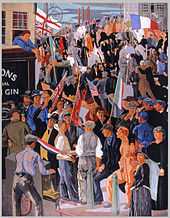Frederick Etchells
Frederick Etchells (14 September 1886 - 1973) was an English artist and architect.
Biography

Etchells was born in Newcastle upon Tyne. His early education was through William Lethaby at the London School of Kensington, now known as The Royal College of Art, which brought him into contact with the Bloomsbury Group.
He was a contributor to the Omega Workshops, but was one of those breaking away with Wyndham Lewis; this breakaway began the Rebel Art Centre, with the Rebel Art Movement, somewhat akin to the Dadaists in Paris. The Rebel Art Movement transformed into the Vorticists several of his illustrations appeared in the issues of the literary magazine BLAST of which there were only two issues. There was a Manifesto, which not all of the artists involved signed up to; Etchells himself excluded his name from the manifesto. However William Roberts later painted Etchells holding the copy of BLAST in his work "The Vorticists at the Restaurant de la Tour Eiffel, Spring 1915". Roberts wrote to Etchells wanting to confront Lewis about his prominence in the authorship of the magazine, to which Etchells declined since he no longer wanted anything to do with it.[1] He, unlike many of the others from the Vorticists, remained acquainted with Roger Fry.
Etchells's most significant work is his translation of Le Corbusier's Vers une architecture known in its English title as Towards a New Architecture: This has now been re-translated by John Goodman in his version Toward an Architecture 2007. Etchells later translated another book of Corbusier's Urbanisme, which in its English translation became The City of Tomorrow. He gradually moved into architecture after a period of book publication, with the Haslewood Press. Later he became a church and conservation architect. He had close associations with John Betjeman who was a tenant in one of his flats in Mayfair, this was during the period when Betjeman was a journalist with The Architectural Review. One of his restorations was St Andrew's Church, Plymouth; he also restored St George's Church, Donnington, West Sussex after a fire in 1939,[2] and St James's Church, Abinger Common, Surrey in 1950 after bomb damage during World War II.[3]
He contributed articles to the journal The Studio.
He was an active member of the Society for the Protection of Ancient Buildings (SPAB) and a founding member of the Georgian Group.
He was married to Hester Margaret Sainsbury[4] who was a book illustrator, painter and artist known for her performances to music.
References
- ↑ Dickson, Malcolm. Etchells (1886-1973), 2005. Architectural Association Library. Interview with Susan Wyatt.
- ↑ Nairn & Pevsner 1965, pp. 208–209.
- ↑ Nairn & Pevsner 1971, p. 85.
- ↑ Philip, Neil. "Oriental delights". Adventures in the Print Trade. Retrieved 6 December 2014.
Sources
- Aldham, Dinah Frederick Etchells, Artist and Architect. London, Architectural Association (dissertation), 1977.
- Dickson, Malcolm. Etchells (1886–1973). London, Architectural Association Library (thesis), 2005.
- Ind, Rosy & Wilson, Andrew "Frederick Etchells: Plain Homebuilder Where is your Vortex?" International Centrum voor Structuranalyse en Constructivisme. (ICSAC) Cahier 9/9: Vorticism. Brussels: 1988.
- Nairn, Ian; Pevsner, Nikolaus (1965). The Buildings of England: Sussex. Harmondsworth: Penguin Books. ISBN 0-14-071028-0.
- Nairn, Ian; Pevsner, Nikolaus (1971) [1962]. The Buildings of England: Surrey (2nd ed.). Harmondsworth: Penguin Books. ISBN 0-300-09675-5.
|
| ||||||||
